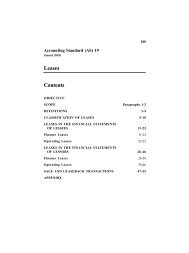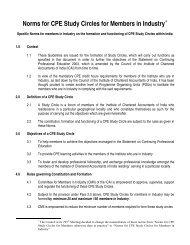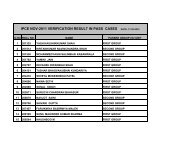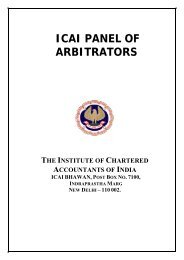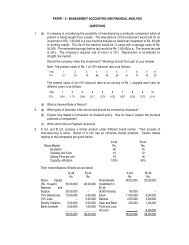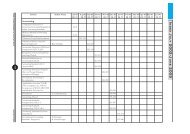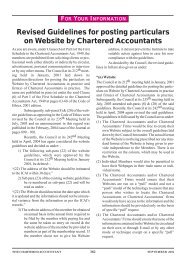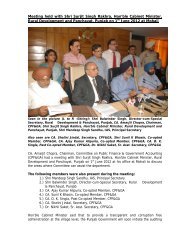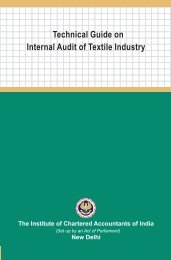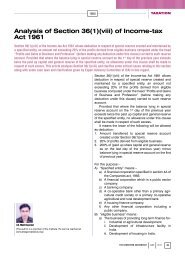The Chartered Accountant
The Chartered Accountant
The Chartered Accountant
Create successful ePaper yourself
Turn your PDF publications into a flip-book with our unique Google optimized e-Paper software.
nised in accordance with the substance<br />
of the agreement. As a practical matter,<br />
this may be on a straight line basis<br />
over the life of the agreement, for example,<br />
when a licensee has the right to<br />
use certain technology for a specified<br />
period of time.<br />
An assignment of rights for a fixed<br />
fee or non refundable guarantee under<br />
a non cancelable contract which<br />
permits the licensee to exploit those<br />
rights freely and the licensor has no<br />
remaining obligations to perform is,<br />
in substance, a sale.<br />
In some cases, whether or a license<br />
fee or royalty will be received is contingent<br />
on the occurrence of a future<br />
event. In such cases, revenue is recognised<br />
only when it is probable that the<br />
fee or royalty will be received, which<br />
is normally when the event has occurred.<br />
21. Effective yield on an Asset<br />
When calculating the effective interest/yield<br />
rate, an entity should estimate<br />
cash flows considering all contractual<br />
terms of the financial asset.<br />
<strong>The</strong> calculation includes all fees paid<br />
or received that are an integral part<br />
of the effective interest rate, directly<br />
attributable transaction cost and all<br />
other premiums or discounts.<br />
For example, Local Body XYZ purchases<br />
a 5-year bond carrying 4.7% interest<br />
(paid annually) with a face value<br />
of Rs. 1,250, for Rs. 1,000 (including<br />
transaction costs).<br />
<strong>The</strong> effective yield rate method is applied<br />
as follow:<br />
Effective Yield Computation<br />
Years Cash inflows /<br />
(outflows)<br />
Year 0 (1,000)<br />
Year 1 59<br />
Year 2 59<br />
Year 3 59<br />
Year 4 59<br />
Year 5 59+1250<br />
Effective<br />
Yield Rate<br />
10%<br />
STANDARDS<br />
Year (a) Amortised<br />
Cost at the<br />
beginning of<br />
the year<br />
(b = a10%)<br />
Interest<br />
income<br />
(c)<br />
Cash flows<br />
(d = a + b – c)<br />
Amortised<br />
cost at the end<br />
of the year<br />
Year 1 1,000 100 59 1,041<br />
Year 2 1,041 104 59 1,086<br />
Year 3 1,086 109 59 1,136<br />
Year 4 1,136 113 59 1,190<br />
Year 5 1,190 119 1,250 + 59 -<br />
As per the effective yield method, the<br />
amount of interest to be recognised<br />
in Year 1 to Year 5 would be Rs. 100,<br />
Rs. 104, Rs. 109, Rs. 113 and Rs. 119<br />
respectively.<br />
Appendix B<br />
Note: This Appendix is not a part<br />
of the Accounting Standard for Local<br />
bodies. <strong>The</strong> purpose of this appendix<br />
is only to bring out the major differences<br />
between this Accounting Standard<br />
for Local Bodies (ASLB) and the<br />
corresponding International Public<br />
Sector Accounting Standard (IPSAS)<br />
9, Revenue from Exchange Transactions.<br />
COMPARISON WITH IPSAS 9,<br />
REVENUE FROM EXCHANGE<br />
TRANSACTIONS<br />
1. Definition of the term ‘Exchange<br />
Transactions’<br />
International Public Sector Accounting<br />
Standard (IPSAS) 9 ‘Revenue<br />
from Exchange Transactions’ issued<br />
by International Public Sector Accounting<br />
Standards Board (IPSASB)<br />
defines a transaction as an exchange<br />
transaction, in which one entity receives<br />
assets or services, or has liabilities<br />
extinguished and directly gives approximately<br />
equal value to other party<br />
in exchange. For determining whether<br />
there is exchange of approximately<br />
equal value requires determining the<br />
fair value of the consideration given<br />
and received.<br />
<strong>The</strong> ASLB 3 however describes an<br />
exchange transaction as one in which<br />
the entity transfers goods or services<br />
or use of assets and receives some<br />
value instead of equal value.<br />
<strong>The</strong> ASLB 3 has changed the definition<br />
of ‘Exchange Transaction’ be-<br />
cause in India most of the transactions<br />
undertaken by Local Bodies providing<br />
goods and services at subsidised prices<br />
does not involve the exchange of<br />
equal value and would not be covered<br />
under exchange transactions. Since<br />
the Local Bodies in India are at a very<br />
early stage of adoption of accrual basis<br />
of accounting, it would be difficult<br />
for the Local Bodies to determine the<br />
fair value for deciding whether there<br />
is exchange of approximately equal<br />
value for a transaction. Consequent<br />
to the above, other changes have also<br />
been incorporated in the proposed<br />
Standard.<br />
2. Materiality of the effect of time<br />
value of money<br />
<strong>The</strong> ASLB 3 ‘Revenue from Exchange<br />
Transactions’ requires to measure revenue<br />
at fair value of the consideration<br />
received or receivable as provided in<br />
International Public Sector Accounting<br />
Standard (IPSAS) 9 ‘Revenue from<br />
Exchange Transactions’ issued by the<br />
International Public Sector Accounting<br />
Standards Board (IPSASB). In<br />
most cases, the consideration is in the<br />
form of cash or cash equivalents and<br />
the amount of revenue is the amount<br />
of cash or cash equivalents received or<br />
receivable. However, in case of the financing<br />
transactions, where the inflow<br />
or outflow of cash or cash equivalents<br />
is deferred, IPSAS 9 requires to measure<br />
the fair value of the consideration<br />
by discounting all future receipts using<br />
an imputed rate of interest. However,<br />
ASLB 3 requires discounting of cash<br />
receipts only when the time value of<br />
money is material. It also provides that<br />
ordinarily, when the inflow of cash or<br />
cash equivalents is deferred beyond a<br />
period of twelve months, the effect of<br />
time value of money is material.q<br />
THE CHARTERED ACCOUNTANT 1079 DECEMBER 2008



